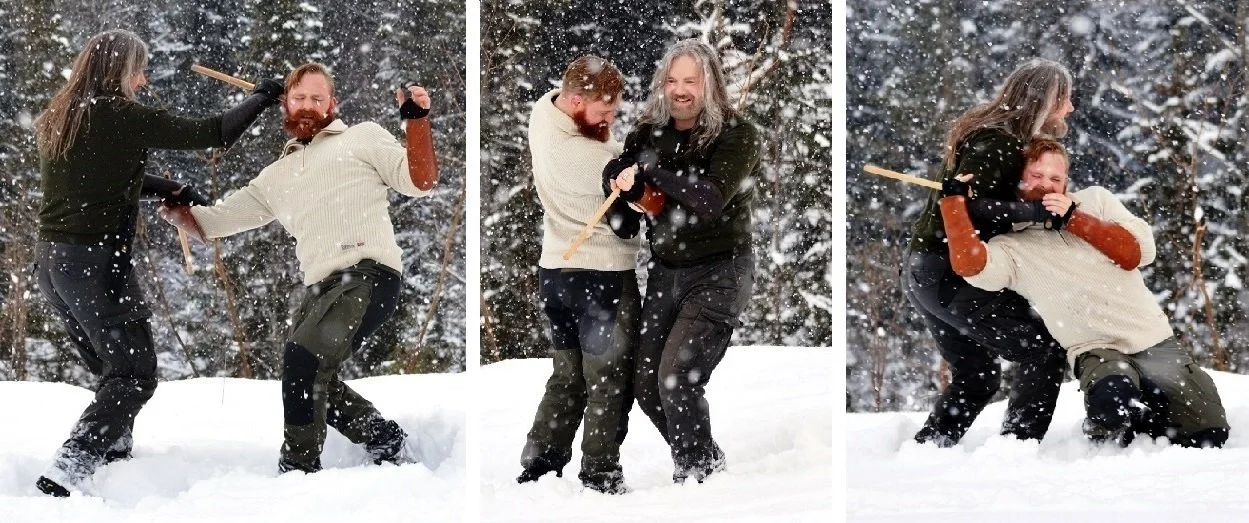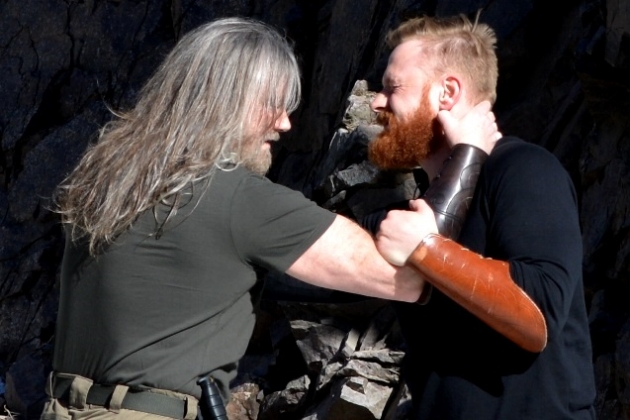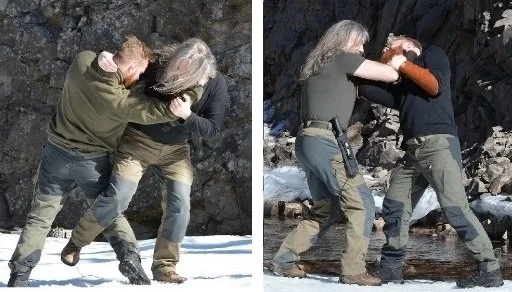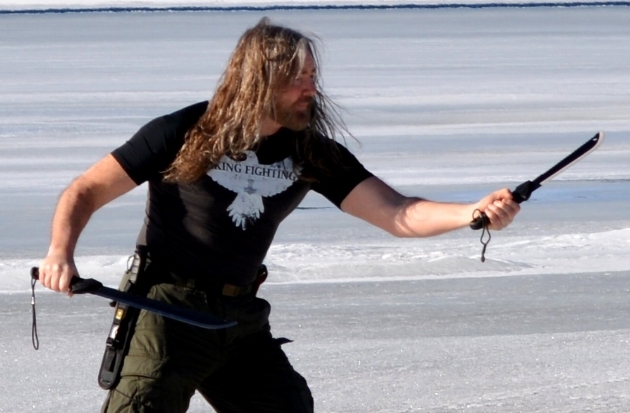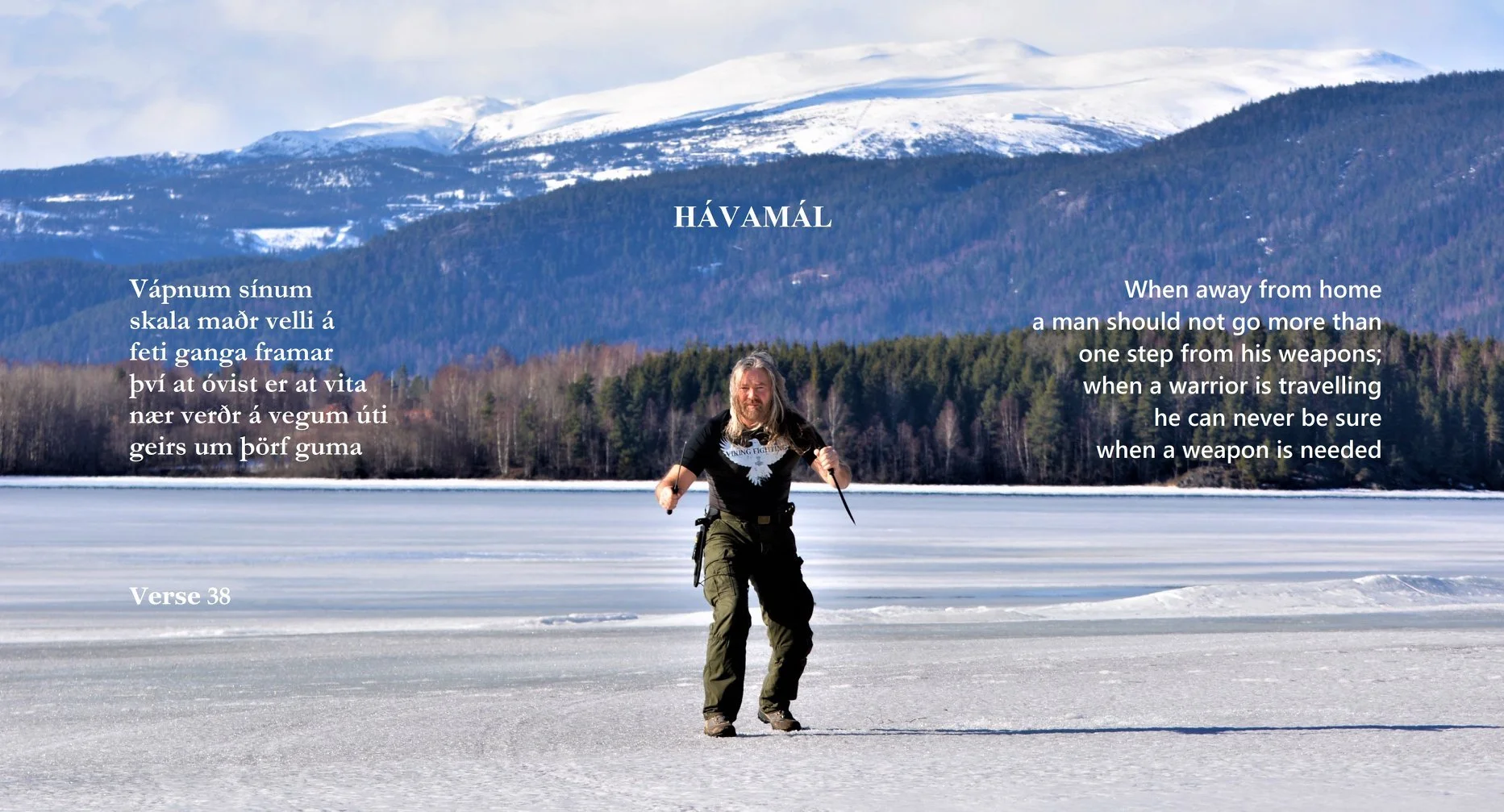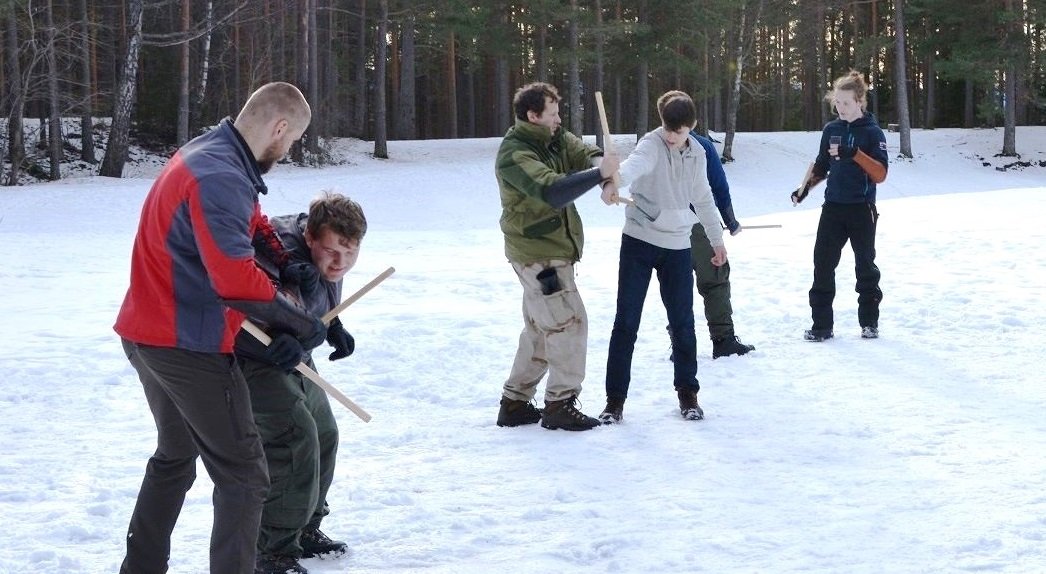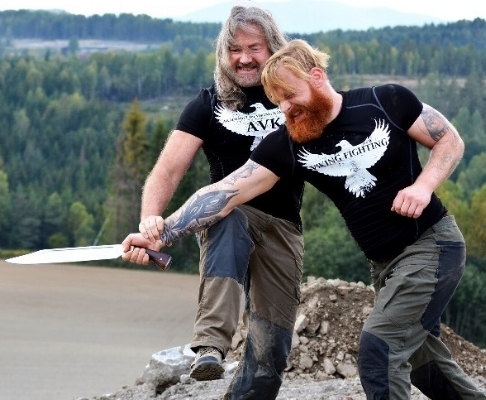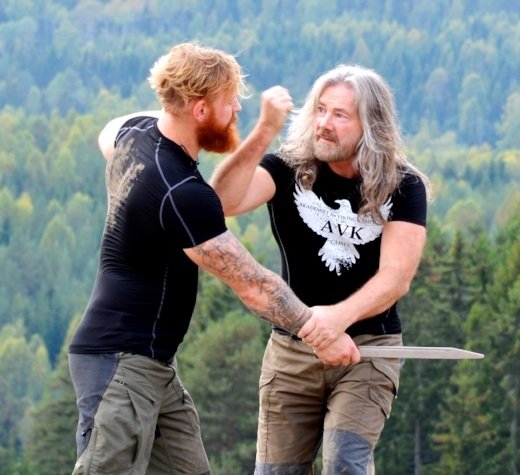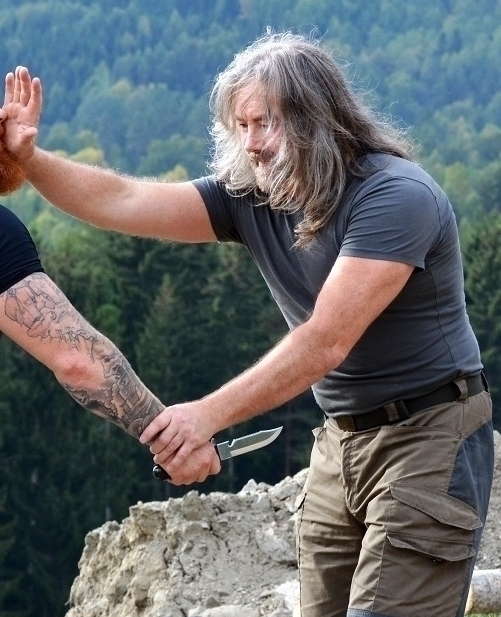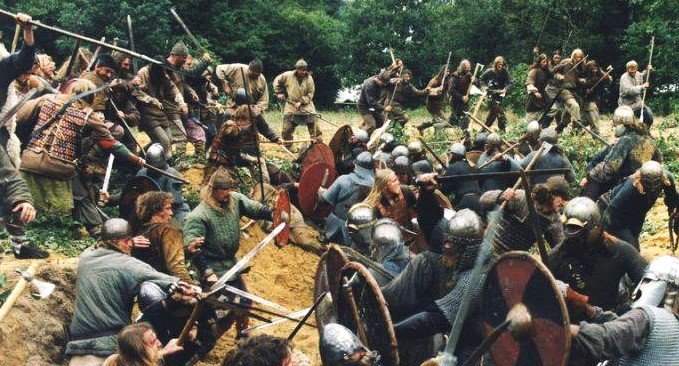Laustak is a self-defence system that has its roots in Viking battlefield wrestling. Laustak contains throws, takedowns, grappling, strikes, kicks, chokes, locks, pain techniques and weapon techniques, and is comparable with the best complete martial arts systems from around the world.
LAUSTAK - The Martial Art of the Vikings by Tyr Neilsen
/The Viking Age is the 300 year period of history between 790 - 1100 A.D. It is also the only period in history named after warriors.
Throughout Europe, Vikings were admired and feared as they opened up trade routes, fought to keep them open, and carved out kingdoms. In the East, Viking warriors were admired and feared as the elite fighting force called the Varangian Guard.
In the Middle East in the year 922, Muslim diplomat Ibn Fadlan wrote that he had never seen more perfect physical specimens than Viking warriors, and that they were the fiercest fighters he had ever seen.
On land and at sea, Vikings had the skills to survive against the various forms of warfare they encountered in their travels around the world. The reason for the Viking warriors fighting prowess is found in the way they trained both with and without weapons.
Viking battlefield wrestling was created and developed by Norse warriors who had to survive attacks from all kinds of weapons. It was a no-nonsense way of fighting that cut out all unnecessary movements, and was tried and tested in single combat and on the battlefield, with life and death on the line.
Over time, Viking battlefield wrestling was given the name Lausatök and was practiced in two forms; wrestling for sport, and wrestling for combat.
Although people all around the world have heard of Vikings, not everyone has heard of the Viking martial art of Laustak, from the Old Norse word Lousatök, which means Loose-grip/Free-grip. The reason for this name was that all grips could be used, instead of a single compulsary grip, which other styles of Viking sport wrestling had.
Laustak techniques include grappling, wrestling, throws, hand strikes, elbow strikes, kicks, chokes, locks, pain techniques and weapon techniques, and Lousatök is comparable with the best complete martial arts systems from around the world.
In Viking Age scandinavia, there were several types of folk wrestling; Lausatök, was loose-grip wrestling, Brokartök was trouser-grip wrestling, and Hryggspenna was back-hold wrestling.
Scandinavian children began training in these forms of wrestling at the age of 6 or 7, and it was practiced by male and female alike.
The people of Viking Age Scandinavia loved all forms of sport, but wrestling was by far the most widespread sport. Wrestling competitions were extremely popular, and wherever the people of the north gathered, it was a big part of the entertainment. Wrestling was so important for Viking society that their most popular god, Thor, was also the god of wrestling.
Viking Age children learned balance, grappling, wrestling, and pain techniques, from training in Lausatök. These techniques could be used for self-defense, and this training formed the basis for Viking armed and unarmed combat. Training in Lausatök also developed strength, reflexes, endurance and courage, the perfect foundation Viking warriors needed to survive in battle.
In order to have a structured form of unarmed combatives against weapons, the Vikings had to know how to use a variety of weapons, such as sword, axe, spear, seax, stick and knife. Through combat glima, Vikings became experts in knife fighting, stick fighting, spear fighting, axe fighting and sword fighting.
Training in Lausatök battlefield wrestling, with and without weapons from an early age, gave the Vikings such a comprehensive combat foundation, that they had no problem adapting to the different styles of warfare, or other fighting styles they met on their travels.
Viking warriors were renowned for their fighting abilities in raids and against larger and less mobile soldiers, because Lausatök, combined with forestry and hunting skills, made Vikings extremely dangerous in guerilla warfare.
Over the centuries, the nature of combat in war has changed due to the constant development of weapons, but when it comes down to hand to hand combat, Laustak is an extremely effective martial art.
Since the Viking Age, glima has always been practiced for realistic combat situations in Scandinavia. From historical documents, we can see that Viking fighting techniques were in use all the way to the 19th century, when Lousatök was used as the foundation for bajonettkamp (bayonet fighting) by the Swedish and Norwegian military.
With the changing methods of warfare, where one on one combat on the battlefield began to disappear, combat glima also began to disappear. At the beginning of the 20th century, Lousatök was even made illegal in some parts of Scandinavia, when all dangerous hand-to-hand combat techniques for the common man were banned. Lousatök survived only by keeping it a secret.
As a sport, Brokartök trouser-grip wrestling not only survived, it developed into what is now known as Icelandic Glima, which became the national sport of Iceland.
There are national championships in all forms of sport glima throughout Scandinavia, and thanks to the interest of Viking groups, Viking festivals, historical reenactment and martial artists, Laustak is gaining in popularity all over the world.
Just as it was in the Viking Age, when Norse warriors had to compete with different styles of fighting from around the world, modern Laustak has continued to develop so that it remains a relevant martial art in today’s world.
As a sport, Laustak builds flexibility, endurance and strength, as well as being energetic, effective, educational and fun. As a means of self-defense, Laustak is a martial art that is unrestricted by style, and can be used against any and all individual martial art techniques.
Laustak - the Martial Art of the Vikings!
Hávamál – verse 15
People should be
quiet and thoughtful
and brave in conflict
Each person should live
happy and joyful
until their last day.
VIKING GRAPPLING by Tyr Neilsen
/Glima grappling tYR NEILSEN
Vikings fought with and without weapons, sometimes for fun, and sometimes to survive. When Viking combatants without weapons ended up so close they could grab hold of each other, they would start grappling.
Vikings battlefield wrestling became a sophisticated combat system, with grappling techniques and maneuvers used to strike, improve position, submit or injure their opponent.
The Laustak grappling position starts with a clinch from a standard combat Laustak stance. The right hand gets a 'cupped' grip on the back of an opponents neck, and the right elbow presses into the opponents chest. The left hand grips the meat of the opponents right forearm.
This Laustak clinch grappling position enables a combatant to control the head and neck of the opponent with the right hand, induce pain and control much of the opponent's torso with the right elbow, and control an opponents right arm with the left hand grip.
By holding an opponent’s neck, or arm, or piece of clothing, a fighter can manipulate the opponent into an angle that makes it easier to strike or choke. By grappling in a clinch, a fighter can also take an opponent off balance and throw them to the ground.
In sport Laustak, grappling is done in an energetic and friendly way, but in combat Laustak, grappling is done to defeat an opponent as fast and as fierce as possible.
During close quarter hand-to-hand combat when opponents end up in a clinch, even though it is a very tight situation, Laustak fighters can use a wide variety of grappling moves which include: takedowns, throws, foot sweeps, reversals, controls, chokes, locks, escapes, strikes and pain techniques.
Laustak grappling is all about using strength with technique to manipulate an opponent into a weaker position. This can be a scary situation because there is little room to dodge a strike or move away from a throw.
Being so close, fighters have to grapple for better grips, better balance and better opportunities, that only offer a very small range of motion. Strikes, chokes, locks, takedowns and throws are highly effective, but can be difficult to execute because they have to be done using the tightest movements.
Grappling techniques happen fast, but because each fighter is holding the other, throws often end up with both opponents landing on the ground together and having to wrestle. This can happen no matter how effectively the grappling techniques are done. But when done correctly, a fighter will end up in the dominant position when ending up on the ground.
Grappling in a clinch often leads to submission holds. From this extremely close position, it is easier for fighters to go after a choke technique, or a joint lock technique.
In sport Laustak, grappling is done with maximum effort, whilst still respecting the opponent, and injury is not the aim. Grappling in combat Laustak is also done with maximum effort, but now the safety of an opponent isn’t a priority. In combat Laustak, if an opponent can’t escape from a choke, he or she can risk becoming unconscious or receiving injury.
Grappling in a clinch is a fight for control. Fighters grapple non-stop for a better position of control, whether it is directly opposite an opponent, to the side of an opponent, or from the back of an opponent. Being behind an opponent in a clinch is an advantageous position since it is harder for an opponent to defend from that position.
Grappling techniques can be offensive or defensive. Sometimes the only grappling techniques that can be used are to escape, or to prevent an escape or attack. Getting out of danger in a clinch means working in a tight space whilst being held, or from a tightly held inferior position, and reversals range from quick movements, to hard fought inch by inch maneuvering. Laustak pain techniques are very effective in these situations.
Sometimes fighters grapple because they are unskilled, fatigued or in pain. This is a common reaction, and the aim is to slow down the conflict by holding an opponent in the hope of some relief by trying to keep the opponent still. Keeping safe in this type of clinch is difficult and a fighter has to be clever to keep protected and keep an opponent from striking or executing a takedown.
Strikes can be used to get into a grappling situation in combat Laustak and sport Laustak, and grappling techniques can be used to set up strikes. In sport Laustak, this would mean open hand strikes used only for distraction or shock value in order to enable a takedown. In combat Laustak, these strikes can be for shock value or to inflict pain or damage.
There are many striking techniques that can be used effectively from a grappling situation, especially in combat Laustak. Open-hand strikes, punches, elbows, head-butts, kneeing and foot stomps can be used effectively in a clinch. Kicks can be nullified to some extent because of the proximity of the opponents, but some kicks are still effective in a clinch.
There are several types of grips or holds that are used to control the head or torso of an opponent in sport Laustak, or in a self-defense situation. Strikes from this extremely close position can be difficult for the unskilled, but a skilled Laustak grappler can utilize a clinch with a variety of pain techniques, chokes, short, quick strikes, or takedowns. When done correctly, they are extremely effective, because the opponent has difficulty rolling with the strike whilst being held.
In combat Laustak or self-defense situation where sport Laustak is used in a grappling situation, the Laustak grip can be utilized on an opponent’s clothing to control their body. This grip on opponents clothing can lead to a choke, lock, throw or takedown. By keeping hold of the clothing from the clinch after a takedown or throw, the clothing can then be used to choke an opponent on the ground.
Laustak grappling is great for building balance, strength, endurance, coordination and confidence. Laustak grappling also provides the opportunity of controlling an opponent without injuring them. These techniques are invaluable to people working in law enforcement or safety and security work.
THE DEADLY MARTIAL ART OF THE VIKINGS by Tyr Neilsen
/DEADLY MARTIAL ART of GLIMA TYR NEILSEN
Laustak is a deadly martial art that works in real-world conflict situations. It was created during a time when Viking warriors faced each other both on and off the bloody fields of battle.
Viking battlefield wrestling was tried and tested over hundreds of years of life and death struggles, with warriors armed with razor sharp steel weapons, or unarmed against them.
Over the centuries, as the weapons of modern warfare changed, combat glima has continued to be vital when the fighting ended up as hand to hand combat.
Laustak is a no-nonsense complete system that covers the use of easily available modern weapons such as knife, stick and axe, and defense against such weapons.
Weapon training starts after students understand and can apply basic unarmed combat Laustak techniques. Working with simple modern weapons such as a stick and knife, not only teaches the mechanics and application of weapon use, it sharpens all unarmed techniques and reinforces coordination.
Weapon training with knife or axe and other modern hand weapons, starts when basic weapon techniques are understood and can be applied by a student.
Historical weapon training is a specialized field taught in historical combat glima classes, as regular combat Laustak classes are geared towards realistic armed and unarmed conflict.
Laustak has hand, elbow and knee strikes, block and shock techniques, kicks, grappling, wrestling, throws, takedowns, groundwork, pain techniques, and locking and choking techniques.
These techniques can be used seperately, or combined in fluid and lethal ways, from standing situations to fighting on the ground.
Laustak open-hand strikes are devastating. They are fast and extremely powerful from all angles. A person can't punch a brick wall with force and expect the hand not to be damaged or broken, but a person can hit a brick wall with force in an open hand strike without damage.
The same is true in combat. After one or many punches, the punching hand can be damaged or swollen, making it useless, but an open hand strike is powerful, remains undamaged, and can quickly turn into a grappling or gouging technique.
Laustak elbow and knee strikes are fearsome and can be used from a variety of angles against a wide range of targets.
Laustak kicks are quick and destructive because they are anatomically proficient and are directed to specific targets that ensure maximum effect. All combat Laustak techniques are executed in such a way as to end a fight as quickly as possible.
There is a big difference between martial arts geared towards sport, self-defense, and combat. All such training helps in conflict situations, but people who train in combat Laustak have an edge over someone trained not to inflict harm.
Combat Laustak classes are divided between training techniques indoors with mats, and year round training outdoors on the hard ground, testing the techniques in combat situations.
Most martial artists, who train for sport or self-defense, do so in a warm and safe environment. They usually train on thick mats that protect them from being hurt if they are thrown, grapple or wrestle.
If a person is only trained in this way, the shock of fighting in a street, with cement or asphalt ground, can be massive. The fear of being hit by an opponent is almost as great as the fear of being slammed to the sidewalk.
Making forceful contact with cement or stone can seriously injure a person, or scare the fight out of them, so the threat of hitting a cement paving stone can stop a person from fighting as they have been trained.
Having skills is an advantage, but being great at ground techniques on fluffy mats does not necessarily convert to being great in a struggle on the street, where usual safe movements end up with bloody elbows, scraped backs, and damaged limbs.
Point contact experts can fall short in a real situation after being trained for years to not connect. There are no rules on the street, which means people trained under strict rules where physical harm is avoided, are disadvantaged.
Sport Laustak has advantages over similar martial arts and wrestling, because the premise, even as a sport, is to get up and away as fast as possible.
This is because sport Laustak came directly from Viking combat situations, where a person did not want to stay long on the ground, enabling a second attacker to kill them.
As it is vital to find out what works in reality, as opposed to demonstration, the last 15 minutes of every Laustak class is competition, where students fight to survive and check out their techniques.
Most techniques look wonderful in demonstrations, but often can’t be used in a street fight. Real fights are ugly and dangerous.
An attacker might never have trained in a martial art, or have recognizable techniques, which makes such fighting unpredictable.
If students never actually test their techniques in stressful and painful situations, they cannot know if their techniques work.
Laustak training creates well-rounded martial artists who understand the differences between sport, competition and real life conflict.
In all forms of Laustak training, opponents fight against all weight classes and ability levels, which leads to hard earned experience. Being used to pain, hitting hard ground, and struggling to win, is extremely important and a massive advantage in a conflict situation.
By training outdoors on hard and sometimes icy ground, students quickly build a strong foundation based on reality, and learn why Lousatök techniques have been developed and why they work.
Year round training outdoors forces Laustak practitioners to disregard the fact that they are fighting on solid ground, and disregard the fact that there are people watching, which is also a massive advantage in a conflict situation.
Having trained in stressful and often overwhelming situations, they have less likelihood of freezing up or freaking out, and have experience in dealing with their fear and other emotions.
Lousatök techniques are taught in such a way that understanding of the techniques is the prime focus. It is not repetition for repetitions sake, but rather internalizing the understanding, so that the body performs in a fluid and dynamic way as it adapts to each new movement and situation.
It is Laustak principles, rather than indoctrination, that are essential, so that the practitioner understands what they can make work in a fight, and what to do next if it doesn’t work.
Training in Laustak ensures that the practitioner becomes steadily fitter and stronger, both physically and mentally.
Year round outdoors training in all type of weather, makes combat Laustak practitioners tougher. Combat competition ends each training session, and through hundreds of such fights, practitioners create the will, ability and determination to dig deep and fight on, when other martial artists might give up.
Laustak training produces fighters that are mentally and physically prepared for conflict, using effective techniques that have been practiced and tested in hard won battles. They are trained in the use of a variety of weapons and trained to defend against armed attackers.
Laustak training gives a real understanding of appropriate techniques, timing, and correct tactics depending on the situation. This is tough reality-based training, that enhances the practitioner’s chances of surviving single or multiple attacker scenarios.
With and without weapons, Laustak is as deadly today as it ever was in the Viking Age.
LAUSTAK - VIKING COMBAT by Tyr Neilsen
/Of the original forms of Viking wrestling, Laustak most closely resembles the close quarters hand to hand battlefield combat of the Vikings, where the aim was to be standing whilst an opponent was down.
Laustak, from the Old Norse word Lousatök, which means Loose-grip/Free-grip, because there was no single compulsary grip or hold in this type of Viking wrestling, but rather the hands can move freely from one grip to another, from one hold to another, and to strikes and grappling.
Laustak as a self-defense and combat system, contains throws, takedowns, strikes, kicks, chokes, locks, pain techniques, and weapon techniques, and is comparable with the best complete martial arts systems from around the world.
As with all martial arts, techniques must continue to develop in order to stay relevant. In order to ensure this, the Norwegian Laustak Federation established a standard for Laustak, with a system for the teaching of Laustak techniques, which includes grading and certification.
Laustak is a powerful self-defense system that focuses on unarmed training at first, then as a student matures, there is training with modern weapons, using safety equipment such as rubber knives and axes, and wooden sticks.
In order to train to protect yourself from a weapon, it is neccessary to train with weapons. By training with weapons, we develop essential skills such as balance, coordination, timing, focus and speed, that we can apply to unarmed combat against a weapon.
Laustak striking is simple and specific. Each strike is aimed at a specific target, with the goal of maximum impact. There are no punches in Laustak, instead we use palm strikes. These can be more devastating than a punch, and there is no risk to damaging your knuckles.
Laustak also specializes in pain techniques, which are used in grappling situations. Thes techniques are incredibly effective, both standing and on the ground, as any Laustak student will attest to.
Laustak is a comprehensive system that will teach you how to defend yourself against armed or unarmed attacks. By training in Laustak, we develop the skills and confidence to defend ourselves in all situations.
In Norway, we train indoors with mats and safety equipment, but we also regularly train Combat Laustak outdoors, year round, in all weather, sun, wind, rain and snow. Just as our ancestors did.
I feel immensely proud to be able to keep this unbroken line from the Viking Age intact, and preserve Viking wrestling techniques so they can be handed over to the next generation. It is an honor to be able to sustain this unique part of the Viking heritage that goes back over a thousand years.
Hávamál - verse 58
Get up early and fight
for what you want
before others take it
A lazy wolf
gets no meat
the sleeping get no victory.
VIKING SPIRIT by Tyr Neilsen
/VIKING SPIRIT TYR NEILSEN
The people of Viking Age Scandinavia lived in a rugged enviroment with a harsh climate. In order to survive and thrive in these conditions, the men and women of the North became tough and resilient.
It was imperative for Viking warriors to strengthen their mind, body and spirit. If they didn't, they became weak and would fall when things got tough.
A physical body is the easiest and quickest to strengthen, but if the spirit is not strong, the body can fail. After the body, the mind is the next thing to strengthen, but again, if the spirit is not strong, the mind will fail.
The spirit is the last thing to develop, as it is the most difficult and time-consuming work, but when the spirit is strong, a determined will is built that keeps the mind and body going when they otherwise would have given up.
Having a strong spirit was a greatly prized quality for Viking men and women. It gave them the capacity to endure hardships, inconvieniences and tough times, and gave them the power and courage to overcome seemingly insurmountable odds and achieve their goals.
Only through struggling through challenge after challenge do we build the neccesary spirit to fight on. Only through this process are we secure in the knowledge that we will get up one more time than we are knocked down, and fight on.
The Norse people believed they were a part of nature, not something living separately from nature. They understood that in nature there is a constant fight for survival.
For the Norse people and Viking warriors, it was of utmost importance to cultivate a strong spirit, simply in order to survive. In order for us to achieve anything like this today, we train outdoors every week, all year round.
This means training in rain, wind, snow, hail, and freezing temperatures, as well as in warm weather. As it is winter for 6 months out of the year in Norway, this type of training forces us to grow strong, tough and resilient. We grow stronger because we choose to train in these conditions.
Laustak training builds the warrior spirit, so that if techniques, strength, and endurance fail, there is still an indominatable will that cannot give in, and a resevoir of determination to overcome.
Laustak training builds a resiliant spirit by continually challenging a student to manage more after he or she felt that they had no more to give. Laustak training builds a confident spirit, by getting a student to get up and fight on, after he or she felt there was no fight left in them.
Doing what it takes to build a strong spirit is not for everyone. Many falter on the way. But those who train in Laustak, and continually push through trials of combat and endurance, create a deep confidence based on the knowledge that they can overcome seemingly insurmountable obstacles, whether it is a physical confrontation or life in general.
It is the duty of a martial arts instructor to remind students of the importance of a strong fighting spirit.
Training to develop a tough and resilient spirit creates other admirable values, such as courage, dependability and moral strength, which benefits not only the individual, but that persons family and society as a whole. This is major part of the foundation of Laustak.
Hávamál - verse 16
Fools think
they will live forever
if they avoid conflict
but old age
gives them no peace
even if they are unharmed
THE VIKING MARTIAL ART OF LAUSTAK by Tyr Neilsen
/Combat Laustak was developed by Viking warriors who had to survive attacks from all kinds of weapons.
It’s a no-nonsense way of fighting that has no unnecessary movements, and has been tried and tested in life and death situations, in single combat and on the battlefield.
In order to survive, Vikings developed a tough and brutal martial art system that could deal with any situation they came across. These armed and unarmed Viking battlefeild wrestling techniques were codified into a system called Lousatök in Old Norse, meaning Loose-grip/Free-grip, which includes striking, grappling, throwing, wrestling, and pain techniques.
Training in combat Laustak develops balance, strength, reflexes, speed, co-ordination, endurance and courage, the perfect foundation Viking warriors needed to survive in battle.
Combat Laustak promotes strength with flexibility and speed, which describes how these techniques are meant to be performed.
In order to have a structured form of unarmed combatives against weapons, the Vikings had to know how to use a variety of weapons, such as sword, axe, spear, seax, stick and knife.
Through combat Laustak, Vikings became experts in axe fighting, knife fighting, stick fighting, spear fighting and sword fighting.
Armed and unarmed combat Laustak training at the Academy focuses on training with modern weapons and equipment. Våpenkamp is the Norwegian name for combat with weapons.
At the Academy, våpenkamp includes working with modern and historical weapons. Sverdkamp is the name for swordfighting, stokkekamp is the name for stick fighting, øksekamp is axe-fighting, and knivkamp is knife fighting.
Knife fighting is an excellent way to sharpen existing unarmed martial arts techniques. Fighting with a knife is a developed skill which builds balance, coordination, timing, focus and speed. It polishes technique and understanding of where you are in hand-to-hand combat. With a knife or unarmed against a knife, knife-fighting sharpens existing skills to the utmost.
Stick fighting is an integral part of combat Laustak weapon training, because once these principles are taken in, they can be used for any cutting weapon. A stick is a very versatile weapon, and there are things that can be done with a stick that can’t be done with cutting weapons, such as locks, chokes and takedowns.
There's no standard size stick in combat Laustak. We train with different sized sticks, which develops adaptability and enables a Laustak practitioner the ability to be ready for any situation.
Close combat Laustak includes short powerful strikes that flow between grappling and wrestling techniques. No move is superfluous or wasted, and there are no traces of unnecessary movement or unneeded style.
Without exception, there are no decorative movements in Viking unarmed combat, and absolutely everything in Laustak is functional and straight to the point. Within striking distance and grappling distance, hands, elbows, knees and feet, are used to their best effect.
Training in combat Laustak with and without weapons from an early age, gave the Vikings such a comprehensive combat foundation, that they had no problem adapting to different styles of hand-to-hand fighting or warfare, they came across on their travels.
Viking warriors were renowned for their fighting abilities in raids and against larger and less mobile soldiers because Laustak, combined with forestry and hunting skills, made Vikings extremely dangerous in guerilla warfare.
Since the Viking Age, glima has always been practiced for realistic combat situations in Scandinavia. From historical documents, we can see that Viking fighting techniques were in use all the way to the 19th century, when Laustak was used as the foundation for bajonettkamp (bayonet fighting) by the Norwegian and Swedish military.
Over the centuries, the nature of combat in war has changed due to the constant development of weapons, but when it comes down to hand-to-hand combat, Laustak is an extremely effective martial art.
With the changing methods of warfare, where one on one combat on the battlefield began to disappear, combat Laustak also began to disappear.
At the beginning of the 20th century, Laustak was even made illegal in some parts of Scandinavia, when all dangerous hand to hand combat techniques for the common man were banned. Laustak survived only by keeping it a secret.
At the Academy we train Laustak indoors with mats and equipment, but we also train outdoors, every week, year round, in all weather. Not only is this very healthy, it reminds students why they don't want to fall, be thrown to, or wrestle on hard ground or ice.
Training outdoors year round on all kinds of ground keeps footwork sharp and purposeful.
Combat Laustak targets the head, for hand and elbow strikes from all angles. These strikes can be done from striking and grappling range. A closed fist where the knuckles hit is seldom used in combat Laustak, as hands are often injured this way, or the knuckles swell and become useless.
A hammer fist, using the meaty part of a clenched fist, is used to good effect sideways and downwards.
Most hand strikes in combat glima are done with an open hand. A palm strike is extremely powerful. It's harder than a punch and seldom injures the hand, (it's better to hit a brick wall with a palm strike than with the knuckles of a punch) and open handed strikes can also transfer immediately into grappling techniques.
Vikings had two arms and two legs, just like their opponents. What set the Vikings apart from other warriors was how they used what they had. In Viking unarmed combat, every move is the most simple and effective possible.
Quick and devastating kicks are sent from the basic Laustak stance to specific targets for maximum effect. A hard kick to the knee or ankle can stop a fight, and kicks can be used to weaken an opponent's attack or defence, opening up possibilities for a successful finish.
Combat Laustak kicks are quick and destructive. In combat, kicks are thrust kicks or snap kicks, aimed primarily below the waist at joints and pain centers. A kick to the area just above the groin, to the top of the thigh, to the knee, or to the ankle area, always have a painfull or breaking effect.
Above the waist, kicks to the ribs area, spine, liver, kidney, middle of the solar plexus, and to the head - if the head is at waist height, are effective. In combat, glima kicks are seldom aimed at shoulder or head height, but training at such targets keeps the body in good shape and defensive moves sharp.
Specific targets take out the guesswork in combat. An elbow to the nose, a knee to the ribs or knee, a kick to the knee, calf or ankle of an attacker, are specific and devastating. If a strike misses by a centimeter or two, it will still make an impact, so long as it was aimed at a specific target.
Use of the hips is extremely important in striking, kicking, grappling, throwing, and wrestling. Hip movement and pushing against the ground gives these techniques their power.
Combat Laustak has an arsenal of aggressive takedown techniques. These are done from grappling distance and of course wrestling situations. These takedowns are brutal from the beginning of execution until forcefully making and opponent hit the ground.
Combat Laustak has destructive throws. These are not just throwing techniques, they create pain and can injure an opponent before the opponent lands on the ground.
There are foot sweep techniques and tripping techniques in Combat Laustak. Again, these are not just sweeps, they are destructive kicks to the limbs of an opponent on the way to becoming sweeps.
Combat Laustak finishing techniques are precise and painful, from standing and grappling, to finishes on the ground with hands, elbows, knees and feet.
Groundwork is where Combat Laustak excels. This is possibly the most continually painful part of a fight, with techniques that deliver unbearable agony.
Combat Laustak drills are done fluidly to create understanding and coordination. Combinations of movements in these drills are never robotic, but allow a student to master techniques, and become efficient in putting techniques together that flow naturally and effectively.
Sparring and competitive matches are a part of every training session, and usually happens at the end of a class. Here students see how the their techniques work in reality, not just in theory or demonstrations.
The Combat Laustak stance is a fantastic foundation that can be used equally effectively for striking and grappling. Footwork is a major part of combat, and once this is understood and can be used, a fighter can concentrate on fighting techniques without distraction.
Advanced basics are practiced constantly. Basics are the fundement, and these fundements are understood at a deeper meaning at each stage of progression. Constantly perfecting basics improves all aspects of combat, and is incredibly important to understand the mechanics of offence, defence and surviving a fight.
Combat Laustak is not just a great martial art for self-defense, it keeps you in shape and builds strength, stamina, flexibilty, balance, coordination, reflexes, awareness, confidence and spirit.
THE VÍKING WARRIOR by Tyr Neilsen
/vIKING WARRIOR TYR NEILSEN - Årbogen, Buskerud County, Norway Photo: T. Neilsen - B. Wemundstad



